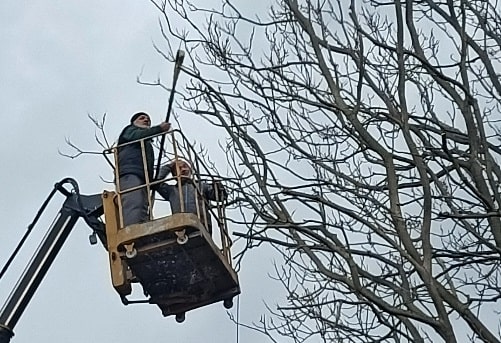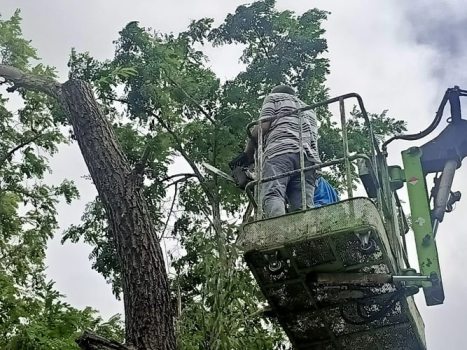When can you cut trees in Wales?
Before carrying out any tree pruning or tree felling activities in Wales, it is important to check with your local authority to determine whether you need a permit, permission or notice. Failure to comply with these regulations can lead to fines or other legal consequences.
The best time for tree pruning in Wales, as in many other places, depends on the specific type of tree and the goals of the pruning. Here are some general guidelines:
- Deciduous Trees: Deciduous trees, which lose their leaves in the winter, are typically pruned during their dormant season, which is late autumn to early spring. This is because without leaves, the structure of the tree is more visible, making it easier to assess its needs. The period between late autumn (after leaf drop) and early spring (before bud break) is ideal for most pruning activities. However, avoid pruning during freezing weather, as this can cause damage.
- Fruit Trees: Fruit trees are often pruned in late winter to early spring, before new growth begins. This is typically done to shape the tree, encourage fruit production, and remove dead or diseased branches.
- Coniferous Trees: Coniferous trees, like pines and spruces, can be pruned during the dormant season as well. However, it’s generally recommended to avoid heavy pruning in late winter, as this might expose the tree to cold damage. Light pruning can be done in the dormant season, while more significant pruning might be better scheduled for late spring to early summer.
- Evergreen Trees: Evergreen trees can be pruned throughout the year, but avoid pruning during extremely hot or cold periods. Light pruning for maintenance, dead branch removal, and shaping can be done as needed.
- Tree Health and Safety: If you notice dead, damaged, or diseased branches, it’s important to remove them as soon as possible, regardless of the season. This helps maintain the health and safety of the tree.

It’s worth mentioning that specific timing can vary depending on the specific tree species, its growth patterns, and the local climate conditions. If you’re uncertain about when to prune a particular tree, it’s recommended to consult with a local arborist or tree care professional who is familiar with the specific needs of trees in your area of Wales. Tree felling in Wales >>
What months are the best for pruning trees in Wales?
The best months for pruning trees in Wales, as in many temperate regions, are during the dormant season, which typically falls between late autumn and early spring. Here’s a breakdown of the recommended months for pruning trees in Wales:
- Late Autumn (November): This is a good time to start pruning deciduous trees after their leaves have fallen. The tree’s structure is more visible, making it easier to assess which branches need to be removed or trimmed.
- Winter (December – February): The dormant period continues through the winter months. During this time, you can continue to prune deciduous trees and fruit trees. It’s important to avoid pruning during freezing weather, as this can lead to damage.
- Early Spring (March – Early April): As the weather starts to warm up and new growth is about to begin, you can continue with your pruning activities. Pruning during this time allows the tree to put its energy into new growth. However, try to finish pruning before the buds fully open.

It’s important to note that different types of trees might have slightly different optimal pruning times based on their growth patterns and flowering times. Some trees might be more sensitive to early spring pruning, while others benefit from it. Additionally, certain situations might require pruning outside of the dormant season. For example, dead or hazardous branches should be removed as soon as they’re identified, regardless of the season.
For coniferous trees and evergreens, the general guidelines of late autumn to early spring still apply, but you might want to lean towards late winter or early spring to avoid cold damage and allow new growth to benefit from the coming growing season.
Overall, when planning your tree pruning activities in Wales, consider the specific species, the goals of pruning (e.g., shaping, health, fruit production), and the local climate conditions. If you’re unsure about the timing or techniques for pruning specific trees, consulting with a certified arborist or tree care professional can provide valuable guidance tailored to your trees and local environment.
Do I need a permit for tree pruning and tree felling in Wales?
Yes, in Wales (as well as in the rest of the UK), you might need a permit or permission for certain tree pruning and tree felling activities. The regulations and requirements can vary depending on factors such as the size of the tree, its location, and whether the tree is protected by conservation laws. Here’s a general overview:
- Tree Preservation Orders (TPOs): Local authorities in Wales can place Tree Preservation Orders on trees that are considered to have significant amenity value. These orders make it illegal to cut down, prune, or damage the trees without the local authority’s permission. If a tree on your property is covered by a TPO, you will need to apply to the local authority for permission before carrying out any pruning or felling.
- Conservation Areas: If your property is located within a designated conservation area, you might need to notify the local authority before carrying out any tree work. Even if the tree is not covered by a TPO, certain trees in conservation areas are protected, and the local authority may have the right to object to their removal or pruning.
- Protected Species: If the tree is a habitat for protected species, such as nesting birds, you might need to delay or adjust your tree work to avoid disturbing these species during their breeding seasons.
- Planning Permission: In some cases, you might need planning permission for tree felling or pruning, especially if the trees are located within a development site or if the work is part of a larger construction project.
- Highways and Public Safety: If a tree overhangs a public road, sidewalk, or footpath, the local authority might have the right to enforce pruning or felling for safety reasons.
- Private Land and Domestic Gardens: Regulations might be different for trees located on private residential property compared to public spaces. However, it’s always best to check with your local authority to ensure compliance.
It’s important to check with your local authority before carrying out any tree pruning or tree felling activities to determine whether you need a permit, permission, or notification. Failure to comply with these regulations can result in fines or other legal consequences.
Keep in mind that regulations and requirements can change, so it’s recommended to contact your local council or a certified arborist for the most up-to-date and accurate information specific to your location in Wales.
How much does tree pruning and tree felling cost in Wales?
The cost of tree pruning and tree felling in Wales can vary widely depending on a range of factors. Some of the key factors that can influence the cost include:
- Tree Size: The size of the tree plays a significant role in determining the cost. Larger trees generally require more equipment, time, and effort to prune or fell, which can lead to higher costs.
- Tree Type: Different tree species have different growth patterns and branch structures, which can affect the complexity of the pruning or felling process. Some trees are easier to work with than others, impacting the cost.
- Tree Health: The health of the tree can influence the cost. Trees that are diseased, infested with pests, or structurally compromised might require specialized techniques or equipment, which can increase the overall cost.
- Accessibility: The ease of access to the tree can impact the cost. Trees that are in difficult-to-reach locations might require additional equipment or more labor, leading to higher costs.
- Location: The cost of living and business expenses in different areas of Wales can affect pricing. Urban areas and more affluent regions might have higher service costs.
- Scope of Work: The specific type of work needed—whether it’s basic pruning, crown reduction, tree removal, stump grinding, or other services—will affect the cost.
- Number of Trees: If you have multiple trees that need attention, you might be able to negotiate a better rate per tree with the tree care service.
- Permits and Regulations: If permits or permissions are required for certain tree work, there might be associated costs for obtaining these documents.
- Additional Services: Some tree care companies offer additional services such as debris removal, chipping, and stump removal. These services can add to the overall cost.
It’s challenging to provide an exact cost range for tree pruning and tree felling in Wales due to the variables involved. It’s recommended to obtain quotes from reputable and certified tree care professionals in your area. When comparing quotes, be sure to ask for a breakdown of the costs and details about what is included in the service. Additionally, consider the expertise, insurance coverage, and equipment quality of the tree care company when making your decision. Tree pruning in Wales >>





